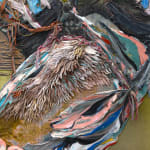-
Artworks







The Abyss Stares Back, 2015
Financial Times stock listings, acrylic, pumice and sand on canvas and sail cloth200 x 450 x 5 cm
78 1/2 x 177 1/2 x 2 inFurther images
The Abyss Stares Back confronts us with an aerial view of Guantanamo Bay, a lingering spectre of ideological hypocrisy. In the distance we see King Solomon’s Temple, fabled to include...The Abyss Stares Back confronts us with an aerial view of Guantanamo Bay, a lingering spectre of ideological hypocrisy. In the distance we see King Solomon’s Temple, fabled to include a hole into which ancient monsters were hurled – creating a mythological parallel with the politically significant landscape. Four bullriders – a recurrent motif in Cheung’s practice, evoking the four riders of the apocalypse – straddle the landscape like placeholders on a board game. The painting’s title refers to Friedrich Nietzsche’s “Beyond Good and Evil”, Aphorism 146 (1886): “He who fights with monsters should look to it that he himself does not become a monster. And when you gaze long into an abyss the abyss also gazes into you.”Exhibitions
Here Be Dragons ( 04/30/2016 to 07/17/2020 )
The Abyss Stares Back ( 10/09/2015 to 11/20/2015 )
Provenance
Private Collection6of 6














